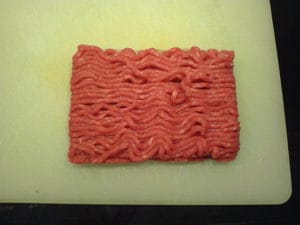Politico
By Bill Tomson and Helena Bottemiller Evich

Gajda-13, Wikimedia
Kids are going back to school and so is the ground beef filler dubbed “pink slime.”
Thousands of schools across the U.S. rushed last year to stop feeding their students meat that contained the ammonia-treated beef, known by industry as lean finely textured beef. Their action followed a massive media uproar, which included a prime time show featuring British celebrity chef Jamie Oliver and a series of critical reports by ABC World News.
But new government data show schools in four more states have since put aside concerns and resumed buying the controversial product.
As of Sept. 3, seven states put in orders to the USDA for about 2 million pounds of beef that may contain the controversial product for the meals they serve in the 2013-14 school year. At this time last year there were only three states — Iowa, Nebraska and South Dakota — that had put in orders for beef that may contain lean finely textured beef.
But as schools across the country grapple with tight budgets, some are changing their minds and accepting the lower-price alternative product that brings down the price of the food they serve. Schools in Illinois, Pennsylvania, Virginia and Texas have now done an about face and also put in orders with the USDA for ground beef that may contain the product, government data obtained by POLITICO reveal.
It’s no wonder. Lean finely textured beef brings down the cost of ground beef by about 3 percent, which can add up quickly in a program that feeds more than 31 million school children each day.
Schools are under more financial pressure than ever before, thanks in part to the new school lunch nutrition standards that hit the ground last year, observes Margo Wootan, head of nutrition policy at the Center for Science in the Public Interest. Although schools can now get six cents more per lunch to help cover the cost of more fruits, vegetables and whole grains to meet new requirements, the increase doesn’t cover all the changes, she notes.
Considered by the beef industry to be an impressive innovation, lean finely textured beef is made from the remnant scraps of cattle carcasses that were once deemed too fatty to go into human food. The scraps are heated and centrifuged to reclaim bits of muscle and then the product is treated with ammonium hydroxide to kill bacteria like Salmonella and E. coli before being mixed into ground beef. Currently, USDA allows these beef products to contain up to 15 percent lean finely textured beef without labeling requirements, but last year the department said it would allow voluntary labeling.
Lean finely textured beef is safe, asserts Al Almanza, administrator of USDA’s Food Safety and Inspection Service.
“Isn’t that what we want – a safe product to feed our families?” he says.
“USDA has repeatedly affirmed that lean finely textured beef is safe, wholesome, and nutritious 100% lean beef,” adds Craig Letch, director of food safety and quality assurance for Beef Products Inc., the largest manufacturer of the product. “With the successful use of LFTB by [USDA’s National School Lunch Program] over the last 15 years, we are confident that these states and school districts will enjoy both quality and cost improvements. This will ultimately enable them to provide more nutritious lean beef to their children.”
CSPI’s Wootan also doesn’t have an issue with LFTB in terms of nutrition or safety. “Mostly it’s just that parents thought it was gross,” she says.
Diane Pratt-Heavner, a director at the School Nutrition Association, which represents school food service directors, said her group is glad the USDA offers states a choice when it comes to purchasing it and confident the product is safe.
Though more states are opting back in, the overall amount of lean finely textured beef purchased by the school lunch program is still way down from its production heyday when most people did not realize the extent of its presence in the U.S. food supply and it was in use in nearly all of the states.
Despite a “Dude it’s Beef” PR campaign — complete with beef state Govs. Rick Perry and Terry Branstad eating LFTB burgers for the press — sales plummeted and three of BPI’s four plants were forced to shut down. Rep. Steve King called, unsuccessfully, for a congressional hearing on what he called a “smear campaign.” BPI has since sued ABC News and former USDA officials, who have been publicly critical of the product, for defamation and $1.2 billion in damages.
In the aftermath, most of the major fast food chains have dropped their use of lean finely textured beef. And, at last count, the number of pounds of lean finely textured beef in the USDA’s National School Lunch Program was down 95 percent. Before the pink slime issue exploded last spring, schools were serving up about 7 million pounds of the product per year.
And it’s not likely that the product will ever get back to its previous glory, based on what school officials say.
Mark Bishop, the vice president of policy for the Healthy Schools Campaign, said he is confident lean finely textured beef will stay out of Illinois’ largest school district: Chicago Public Schools.
“They’ve taken the position that they’re not going to buy meat treated with ammonia and they’ve followed through on that,” Bishop said. “This issue is really about labeling more than it is about nutrition. Whether in our homes or in our schools, we want to make informed choices. We want to know what’s in our food.”
But Bryan Black, a spokesman for the Texas Department of Agriculture, told POLITICO his state has not changed its policy on lean finely textured beef in school lunches. “It has always remained the same, it’s a local decision. Schools have the option to request the type of beef they want to serve and USDA fulfills those orders,” Black said.
School nutrition officials for the three other states opting to purchasing the product were contacted, but did not respond for comment.
But Bettina Siegel, the Houston mom who launched a change.org petition last spring to demand the USDA not purchase lean finely textured beef, is troubled that the product is making any kind of a comeback in schools.
“The vast majority of kids participating in the school lunch program are economically dependent on those meals,” Siegel said. “They have no choice but to eat what they’re served, and I believe we can do better by them than serving them beef with LFTB. That’s why I started my petition in the first place.”
That petition garnered more than a quarter of a million signatures in nine days, leading USDA to announce that — though it considers lean finely textured beef safe and nutritious — it would give schools a choice on whether to buy it.
Around the same time last year, all of the nation’s top grocery retailers also dropped the product from their ground beef. Costco was one of the only major players who stayed out of the controversy because they never adopted the product.
“We just didn’t think it was right. We never used it and we never will,” said Craig Wilson, Costco’s head of quality and food safety. Wilson said the company’s decision was based on quality and consumer perception, not safety. “It would be awfully hard to explain to a mom why we added LFTB to our 100% ground beef.”
Maine is not one of the states that has opted back into using lean finely textured beef. But Rep. Chellie Pingree (D-Maine) has introduced a bill to require labeling for the product.
“As a parent, I wouldn’t want pink slime in my kid’s school lunches, but ultimately that decision is up to parents and school systems,” Pingree said. “But for anyone to make an informed decision they need accurate information, so I’m glad the USDA has agreed to make sure school systems know when they are ordering meat that has this product in it.”

